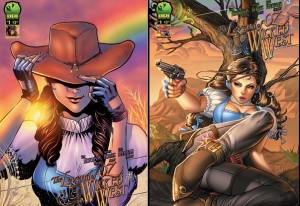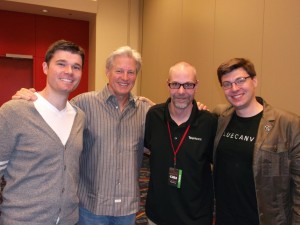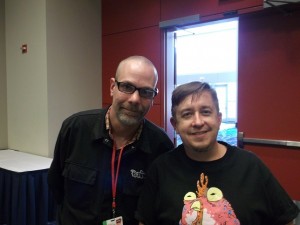Recently, I had the opportunity to sit down with Jordan Hembrough of the Travel Channel’s The Toy Hunter. Since Wonderworld Comics is a big seller of collectible toys, it made sense to interview Jordan Hembrough for this site. Can you think of a better way to officially launch the Toy Collecting section of this site?
Larry Poupard: What is the top item you would love to “discover” on a future episode of The Toy Hunter?
Jordan Hembrough: I am really intrigued right now by the Battlestar Gallactica line. There are some ships that are really rare and if I saw them, I would buy them right there. I would love to have some of those on the show.
Larry: Can you give me a few examples of toys you purchased before the show began which you wish could have been featured on the show?
Jordan Hembrough: Oh, sure. I have always been interested in Kenner toys. One day, a gentleman brought me an original wax sculpture of Boba Fett for the toy from Star Wars. It was the only sculpture of its kind in the world. I would have loved to have had the cameras rolling on that one.
Larry: What are your favorite items in your personal collection?
Jordan Hembrough: My vintage Star Wars toys. They are not worth a lot of money, but they are worth a lot to me.
Larry: Other than money, storage, and knowledge, what are the greatest obstacles a new toy collector or flipper is going to face?
Jordan Hembrough: Good question. They are going to need to really want to keep going. There are going to be times where you overpay for a toy or for a collection, but you are going to want to keep going. You are going to make mistakes, but that is just a factor of the game. You just need to keep going and going and going.
Larry: I am sure you have seen the negative press going on with Storage Wars and the insinuations of the placing of items by producers in the attempt to make a show look better.
Jordan Hembrough: (Smiling) Salting
Larry: Yes. Do you believe this type of publicity for Storage Wars will eventually have a negative impact on your show’s ratings?
Jordan Hembrough: That is an interesting question. [After a long pause] First and foremost, I think you need to remember something. This [Storage Wars] is a show, done for entertainment purposes and for educational purposes. Reality in real life is boring. Do you really want someone to look through a storage locker and not find anything? I think that if they were to make a little disclaimer, it might make the show a little easier to understand.
You know, there are times on our show when we don’t find anything, and it does not turn out they way we had expected, so we have to come up with a “Plan B.” This would be times in which we went through an entire questions really quickly or there was just nothing worthy of airtime.
You have to look at it this way. You are doing a show on TV. You are doing this show for entertainment purposes. While youa re not lying to anybody by salting or staging a little now and then, it is OK. The end result, the ultimate result, is entertainment and education. I believe that people as a whole, understand that it is a TV show.
Larry: For The Toy Hunter, would you say that education is more important, entertainment is more important, or is there some type of needed balance between the two?
Jordan Hembrough: They are both combined. They are both combined, because I am reminded every day by the numbers that the Travel Channel caters to a wide audience. While the network caters to a wide audience, we are geared towards a certain demographic. Not all of our fans are die-hard toy collectors. We cater to people who want to be entertained. We have to keep it lively and we have to keep it fun.
I am a die-hard collector. I am a geek. I am a dweeb. I love this. We are not just making a show for the half million to million people out there who are heavy collectors. We are also making a show for five million other people. We balance these two by making a show with both entertainment and education.
Larry: As a collector myself, I have noticed a huge advantage and disadvantage coming within the last few years which I would like to get your opinion on. Would you say that having Internet access on your phone during picks helps you more or hurts you more?
Jordan Hembrough: For the most part, it has helped me in buying because I can research on the fly. The negative with all of the specialized websites and auction sites is that any Tom, Dick, and Harry can go on the Internet anywhere and know what something is selling for or just went for. Generally, that is a good thing, however, they are taking all of this pricing to heart as doctrine. They do not know about all of the other factors of collecting in the world.
Maybe, the one guy in the world who was going to buy a particular item at a really high price just bought it. Maybe there is a huge warehouse find which just happened in the Midwest will flood the market with a certain toy and these toys which are selling for $500 are now only going to be worth $200. It is a double-edged sword, but for the most part, I find it very helpful.
Larry: I used to be a pulp collector but watched the market die when eBay and other sites became flooded with the short story magazines. Pulps which used to sell for $150 now sell for about $10 since there are so many at any given time on eBay. What type of collectible market or submarket, in your opinion, has been damaged the most by online selling?
Jordan Hembrough: That is a great question. I would say that it would probably be vintage Star Wars because now people realize how much there was of it. For so long, whenever I would mention vintage Star Wars, people would say “Oh, those must really be rare.” No, not rare. Now, vintage Star Wars toys are all over the place.
The problem came when people saw one or two items going for a bunch of money online and they went and pulled everything out and exclaimed “This is vintage Star Wars!” People think it is going to be worth millions, but it is not. Definitely, vintage Star Wars was impacted the most by online selling.
Larry: Is there a specific toy or line of toys which you are leery about buying because of the number of fakes out there.
Jordan Hembrough: I would say Transformers because there are many fakes and knock=offs coming out of Japan right now. Now, I don’t know everything there is about the Transformers market, but I have someone who works with me who can point out the bootlegs from Japan. I am often getting people saying they have original Transformers, but I am able to walk away from them. I might have to explain that, “Yes, those came from Japan, but they are not the real Transofrmers.”
Whenever you have a toy that is hot, there are going to be bootlegs and fakes. There will always be in this market. Because of that, Transformers scares the hell out of me right now. There are so many fakes rolling around that it is not a market worth trying.
I found Jordan Hembrough to be knowledgeable and approachable. I hope his show continues to be successful and look forward to seeing him again in the future. You can learn more about Jordan Hembrough, and his show, by following this link.



